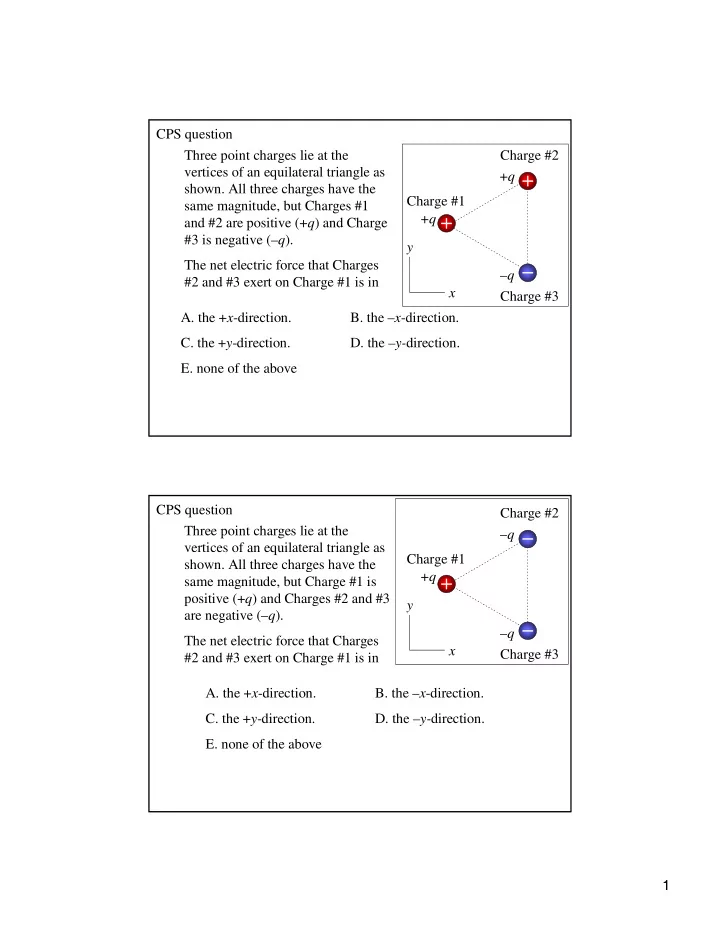

CPS question Three point charges lie at the Charge #2 vertices of an equilateral triangle as + q shown. All three charges have the Charge #1 same magnitude, but Charges #1 + q and #2 are positive (+ q ) and Charge #3 is negative (– q ). y The net electric force that Charges – q #2 and #3 exert on Charge #1 is in x Charge #3 A. the + x -direction. B. the – x -direction. C. the + y -direction. D. the –y- direction. E. none of the above CPS question Charge #2 Three point charges lie at the – q vertices of an equilateral triangle as Charge #1 shown. All three charges have the + q same magnitude, but Charge #1 is positive (+ q ) and Charges #2 and #3 y are negative (– q ). – q The net electric force that Charges x Charge #3 #2 and #3 exert on Charge #1 is in A. the + x -direction. B. the – x -direction. C. the + y -direction. D. the –y- direction. E. none of the above 1
Electric field We can define the “electric field” as the electric force per unit of charge F E = q 0 is called a “test charge” q 0 The force exerted on an arbitrary point charge by a field is: = F q E 0 Remember: the force on a charged body is exerted by a field created by other charges Electric field (rigorous definition) The presence of the “test charge” may affect the distribution of charge on the body creating the field (e.g. metal). So the field before and after may be different we probe it with the charge. We want to avoid this situation by taking the “limit”: F = E lim q q → 0 0 0 In practice, we take the charge distribution to be fixed 2
Electric fields may be mapped by force on a test charge If one measured the force on a test charge at all points relative to another charge or charges, an electric field may be mapped. Electric field of a point charge 1 qq = ˆ F 0 r πε 2 4 r 0 1 q = ˆ E r ⇒ πε 2 4 r 0 3
Electric field of a point charge (cont.) 1 q = ˆ E r πε 2 4 r 0 The field points away from the positive charge, and toward the negative charge Electron trajectory in a uniform electric field F − eE = y = a y m m 4
Electron trajectory in a uniform electric field = x v t 1 eE 0 x = − 2 y x − 1 1 eE ⇒ = + 2 → = 2 2 mv y v t a t y t ox 0 y y 2 2 m = v 0 oy Electric field calculations = + + + E r E r E r E r ... 1 2 3 ⎛ ⎞ 1 q q q = + + + ⎜ 1 r ˆ 2 r ˆ 3 r ˆ ... ⎟ ⎜ ⎟ πε 1 2 3 2 2 2 4 r r r ⎝ ⎠ 0 1 2 3 5
CPS question Charge #1 Two point charges and a point P lie – q at the vertices of an equilateral triangle as shown. Both point P charges have the same magnitude q but opposite signs. There is nothing y at point P . + q The net electric field that Charges x Charge #2 #1 and #2 produce at point P is in A. the + x -direction. B. the – x -direction. C. the + y -direction. D. the –y- direction. E. none of the above CPS question Charge #1 Two point charges and a point P lie – q at the vertices of an equilateral triangle as shown. Both point P charges have the same negative charge (– q ). There is nothing at y point P . – q The net electric field that Charges x Charge #2 #1 and #2 produce at point P is in A. the + x -direction. B. the – x -direction. C. the + y -direction. D. the –y- direction. E. none of the above 6
Field of an electric dipole Charge density dQ λ = → = λ Q dx Linear distribution: ∫ dx dQ σ = → = σ Q ds Surface (2D) ∫∫ ds distribution: Surf . dQ ρ = → = ρ Q dv Volume (3D) ∫∫∫ dv distribution: Volume 7
Field of a ring of charge Field of a line of charge 8
Field of a disk of charge Field of two parallel charged sheets 9
Electric field lines Imaginary lines or curves drawn through a region of space such that their tangent at any point are in the direction of the electric field vector at that point Electric field lines (cont.) •Higher density of lines → stronger field •Arrows define the direction of the field •Field lines never intersect (the field is uniquely defined at each point) 10
Electric dipoles Pair of charges with equal magnitude and opposite sign (q,-q), separated by a small distance d Force and torque on electric dipole 11
Recommend
More recommend